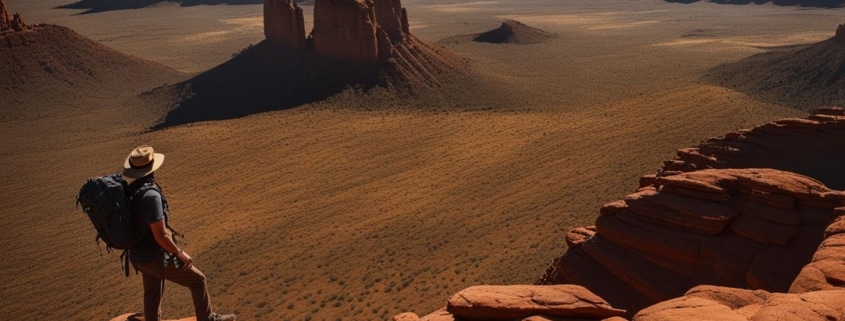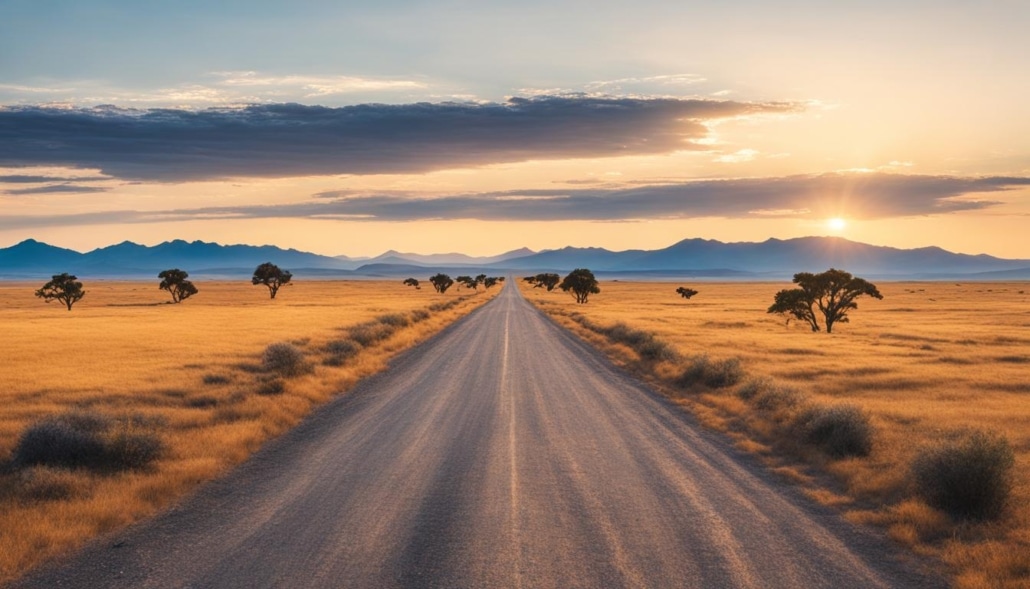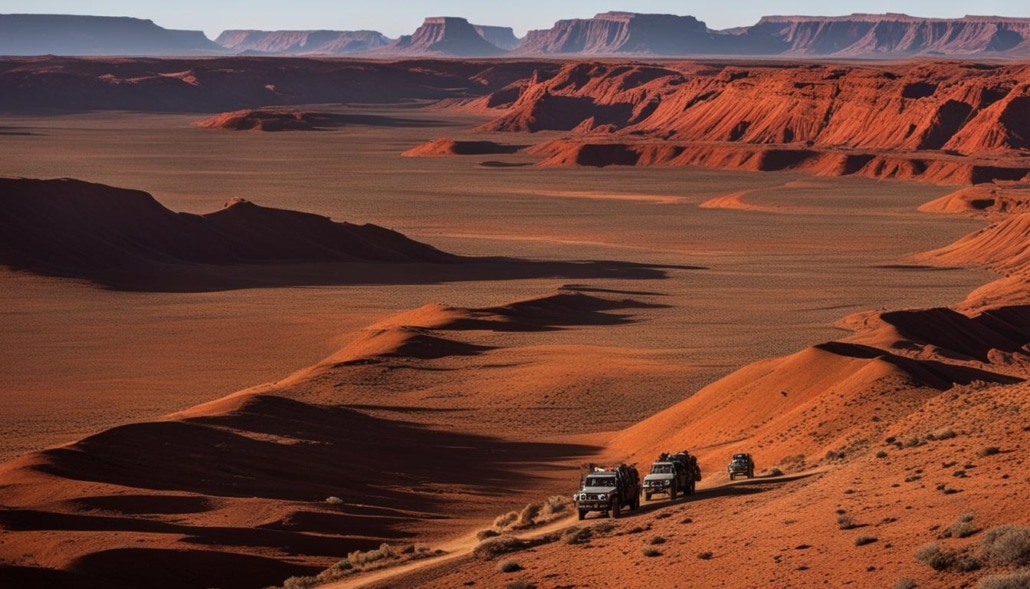The Ultimate Guide to Exploring the Australian Outback
Are you ready for an unforgettable adventure in the Australian Outback? This vast and rugged landscape offers endless opportunities to experience the thrill of exploration. From the iconic sights of Uluru and Alice Springs to the remote beauty of the Red Centre, the Outback is a haven for adventure seekers.
In this comprehensive guide, we will provide you with essential travel tips and insights to make your journey through the Australian Outback an extraordinary experience. Whether you’re a seasoned traveler or embarking on your first Outback adventure, we’ve got you covered.
Get ready to immerse yourself in the rugged beauty of the Outback and discover the wonders this unique landscape has to offer. Prepare for awe-inspiring landscapes, cultural experiences, and encounters with remarkable wildlife. Let’s embark on the ultimate adventure together!
When to Visit the Outback
The best time to visit the Australian Outback is during the winter months, from June to September. The scorching summer temperatures can be unbearable and limit your activities in the Red Centre. In winter, you can enjoy milder temperatures and engage in various outdoor activities without the discomfort of extreme heat. Be sure to pack warm clothing as the Outback can get especially cold during winter nights.
Visiting the Australian Outback during the winter months offers numerous advantages. The weather is pleasant, with daytime temperatures ranging from 20-25°C (68-77°F), making it ideal for exploration and outdoor adventures. The captivating landscapes of the Outback, such as Uluru and Kata Tjuta, are more enjoyable to explore without the scorching heat of summer.
During the winter months, you can embark on captivating hikes, explore waterholes, and witness stunning sunsets at your own pace. The cool nights provide an opportunity for stargazing and experiencing the tranquility of the Outback under a celestial canopy.
“Winter in the Outback offers a different perspective, revealing a captivating beauty that is uniquely Australian. The cooler temperatures provide a more comfortable experience, allowing you to fully immerse yourself in the natural wonders of this iconic landscape.”
If you’re planning a visit to the Outback, it’s important to pack appropriately. Even though winter temperatures are generally mild during the day, they can drop significantly at night. Be sure to bring warm clothing, including jackets, hats, and gloves, to ensure you stay comfortable throughout your trip.
While the Outback is known for its extreme temperatures, it still experiences winter. The average minimum temperature during winter is around 3-8°C (37-46°F), so it’s crucial to be prepared for cold nights. Layering your clothing will allow you to adjust to changing temperatures throughout the day.
Overall, the winter months from June to September provide the best conditions to explore the Australian Outback. The milder temperatures, breathtaking scenery, and immersive experiences make this the ideal time to embark on an unforgettable adventure through the heart of Australia.
Getting to the Outback
Traveling to the Australian Outback has become more convenient and affordable, opening up this stunning destination to adventurers from around the world. There are multiple ways to reach the Outback, whether you prefer the speed and convenience of air travel or the freedom and flexibility of a road trip.
Flying to Melbourne
Melbourne, located on the southeastern coast of Australia, serves as a popular gateway city to the Australian Outback. Qantas, the national airline, offers non-stop flights from various international airports, including major cities on the West Coast of the United States. With the availability of direct flights, your journey to the Outback can become a seamless and enjoyable experience.
Once you arrive in Melbourne, you can take the next step of your adventure by boarding a domestic flight to Alice Springs, the largest town in the Outback. Several airlines offer multiple daily flights between Melbourne and Alice Springs, making it easy to reach your final destination. The flight duration is approximately 2 hours and 30 minutes, allowing you to cover a significant distance in a short amount of time.
Driving to the Outback
If you prefer a more immersive and scenic travel experience, you can choose to explore the Outback by car. However, it’s important to note that driving to the Outback requires careful planning and preparation. The vast distances and rugged terrain demand a reliable vehicle, sufficient fuel, and a comprehensive understanding of the road conditions.
When embarking on a road trip to the Outback, it’s advisable to start your journey in Alice Springs, where you can rent a car and stock up on supplies. From there, you can venture further into the heart of the Outback, exploring its awe-inspiring landscapes at your own pace. Be prepared for long drives and remote stretches of road, as well as limited services and facilities along the way.
“The Australian Outback offers a remarkable sense of freedom and solitude that can only be fully appreciated through a road trip. It allows you to truly immerse yourself in the vastness and beauty of this unique landscape.” – Outback Explorer Magazine
Regardless of your chosen mode of transportation, embarking on a journey to the Australian Outback promises extraordinary experiences and unforgettable memories. Whether you choose to fly or drive, the adventure begins as soon as you set foot in this awe-inspiring region.
Exploring the Outback
Once you’ve arrived in the Australian Outback, there are various ways to embark on your journey and explore the wonders of this unique landscape. Booking a tour with a reputable company, such as Intrepid Travel, can provide you with a well-rounded experience that ensures you make the most of your time in the Outback.
One of the ultimate highlights of exploring the Outback is visiting Uluru. This iconic sandstone monolith holds immense cultural significance for the indigenous Anangu people, who have been custodians of the land for thousands of years. With its imposing presence and vibrant colors that transform with the changing light, Uluru is not only a breathtaking sight but also a symbol of spiritual and cultural heritage.
It is important to approach Uluru with respect and observe the cultural ethics and guidelines set by the Anangu people. Climbing Uluru is considered deeply disrespectful and is strongly discouraged. Instead, take the opportunity to learn about the cultural significance of the site through guided walks and storytelling experiences led by knowledgeable indigenous guides.
| Tour Company | Experience |
|---|---|
| Intrepid Travel | A guided tour that provides in-depth insights into the cultural significance of Uluru and the Outback. It includes visits to other notable sites, such as Kata Tjuta and Kings Canyon. |
| Outback Spirit | An immersive tour that offers a deeper understanding of the indigenous culture and spirituality of the Outback. It incorporates visits to sacred sites, traditional storytelling sessions, and interactions with local communities. |
| Adventure Tours Australia | A comprehensive tour that encompasses the highlights of the Outback, including Uluru, Kata Tjuta, and the MacDonnell Ranges. It also offers the opportunity for outdoor activities such as hiking and camel riding. |
These tours provide a well-rounded experience, allowing you to explore not only the iconic sites but also the hidden gems of the Outback. The knowledgeable guides will share their insights into the history, cultural significance, and unique flora and fauna of the region, creating a truly immersive and educational experience.
Exploring the Outback through a guided tour ensures that you have a deeper appreciation for the cultural significance of Uluru and the natural wonders of the region. You’ll also have the opportunity to connect with the rich indigenous heritage of the Outback and gain a greater understanding of the spiritual connection between the land and its people.
Must-See Sights in the Outback
The Australian Outback is home to a multitude of must-see attractions that will leave you in awe of its natural beauty. From stunning rock formations to breathtaking landscapes, there is something for everyone to enjoy in this rugged wilderness.
Kings Canyon
Kings Canyon is a true gem of the Australian Outback. Located in Watarrka National Park, it offers spectacular scenery and thrilling hiking trails that provide unforgettable experiences. The highlight of Kings Canyon is the rim walk, which takes you along the edge of the canyon and rewards you with breathtaking views of the surrounding landscape.
Kata Tjuta
Also known as the Olgas, Kata Tjuta is another iconic rock formation in the Outback that should not be missed. Comprising a series of domed rock formations, Kata Tjuta showcases the raw power and beauty of nature. Take a walk through the Valley of the Winds to appreciate the sheer magnitude of this geological wonder.
MacDonnell Ranges
The MacDonnell Ranges, a hidden treasure of the Outback, is a must-visit for nature enthusiasts. Stretching over 650 kilometers, this ancient range offers stunning landscapes, scenic gorges, and unique rock formations. Explore the West MacDonnell National Park to witness the rich Aboriginal cultural heritage and enjoy activities such as hiking, swimming, and camping.
“The Australian Outback is a breathtaking destination filled with natural wonders that will leave you speechless. From Kings Canyon to Kata Tjuta, and the MacDonnell Ranges, these iconic attractions showcase the diverse beauty and rugged charm of this unique region.”
Whether you choose to hike through ancient canyons, marvel at towering rock formations, or simply take in the vastness of the Outback, these must-see sights will provide you with unforgettable experiences and memories that will last a lifetime.
Wildlife and Nature in the Outback
The Australian Outback is much more than just a vast desert. It is a place of extraordinary biodiversity, home to a wide range of unique wildlife and stunning natural landscapes. As you venture through this rugged terrain, keep your eyes peeled for encounters with some of the Outback’s iconic animal species.
Firstly, the Outback is synonymous with kangaroos. These fascinating marsupials can frequently be spotted bounding through the arid landscapes, showcasing their incredible agility. Emus, the flightless birds that are the second-largest in the world, are another common sight. Their distinctive appearance and curious nature make them a delight to observe in their natural habitat.
“The Outback is a wildlife enthusiast’s paradise, offering a chance to witness the beauty of creatures uniquely adapted to this harsh environment.”
In addition to kangaroos and emus, the Outback is also known for its dingo population. These wild dogs, with their sandy-colored fur and sharp hunting instincts, are an integral part of the Outback’s ecological balance. Observing these elusive creatures in their natural habitat can be a thrilling experience.
And it’s not just the land-dwelling animals that will captivate you. The Outback is also a haven for bird enthusiasts. As you explore the vast skies, you’ll encounter a diverse array of bird species, including colorful parrots, majestic wedge-tailed eagles, and the striking black swans that find refuge in the region’s waterways.
To safeguard the unique biodiversity of the Outback, a number of national parks and nature reserves have been established. These protected areas not only serve as critical habitats for wildlife but also offer visitors an opportunity to immerse themselves in the diverse flora and fauna of this remarkable region.
Two notable national parks in the Australian Outback are:
- Kakadu National Park: This vast park, located in the Northern Territory, is a UNESCO World Heritage site and showcases dramatic landscapes, ancient rock art, and a rich variety of plant and animal species.
- Litchfield National Park: Just a short drive from Darwin, this park is renowned for its spectacular waterfalls, crystal-clear swimming holes, and unique termite mounds.
Exploring these national parks will reveal the remarkable beauty and ecological significance of the Outback, providing a deeper understanding of this captivating region.
Discover the Unique Flora and Fauna of the Outback
The Australian Outback is not just a barren landscape; it is teeming with life and offers a chance to witness flora and fauna that exist nowhere else in the world. From towering termite mounds to vibrant wildflowers, the Outback’s flora is as diverse as its wildlife.
One notable plant species found in the Outback is the spinifex grass. This adaptable and resilient grass thrives in arid conditions and plays a crucial role in stabilizing the sandy soil. On the other end of the spectrum, carpets of wildflowers bloom after the rains, transforming the barren landscape into a riot of color.
“The Outback is home to unique plant species that have evolved to survive in the harsh conditions, making them a testament to the resilience of nature.”
Exploring the Outback will expose you to the awe-inspiring beauty of its unique landscapes and the intricate relationship between its flora and fauna. Whether you’re marveling at the grace of a kangaroo bounding across the red sand or admiring an ancient rock art site, every moment spent in the Australian Outback is a celebration of the natural world.
Essential Tips for Outback Travel
When traveling in the Australian Outback, it’s important to keep a few tips in mind to ensure a smooth and enjoyable journey. From dealing with flies to staying hydrated and connected, here are some essential travel tips for exploring the vast and rugged beauty of the Outback.
Dealing with Flies
Flies in the Outback can be quite bothersome, but there are a few ways to keep them at bay. Be sure to pack insect repellent and wear fly nets to protect yourself from these persistent insects.
Water Supply
Water sources in the Australian Outback can be limited, so it’s crucial to ensure a reliable water supply during your travels. Carry enough water for your journey and consider using water purification tablets or a water filter if necessary. Remember that tap water may not always be drinkable, so rely on bottled or treated water.
Internet Access
Internet access in the Outback can be scarce, so it’s best to be prepared for limited connectivity. Consider downloading offline maps and travel guides to your devices before setting off on your adventure. Additionally, the WikiCamps app is a useful resource for finding campsites and essential information even when offline.
Summary of Essential Tips for Outback Travel
| Travel Tips | Details |
|---|---|
| Deal with Flies | Pack insect repellent and wear fly nets to keep flies away. |
| Ensure Water Supply | Carry enough water and use purification methods if necessary. |
| Prepare for Limited Internet Access | Download offline maps and use the WikiCamps app for campsite information. |
Conclusion
Exploring the Australian Outback is a truly extraordinary adventure that allows you to immerse yourself in the rugged beauty of this unique landscape. From the iconic Uluru to the hidden gems of the MacDonnell Ranges, the Outback offers endless opportunities for exploration and discovery.
By following these travel tips and embracing the challenges of the Outback, you will create unforgettable memories and have an experience like no other. Remember to pack your bags, prepare for an adventure of a lifetime, and get ready to discover the wonders of the Australian Outback.
FAQ
When is the best time to visit the Australian Outback?
The best time to visit the Australian Outback is during the winter months, from June to September. The scorching summer temperatures can be unbearable and limit your activities in the Red Centre. In winter, you can enjoy milder temperatures and engage in various outdoor activities without the discomfort of extreme heat. Be sure to pack warm clothing as the Outback can get especially cold during winter nights.
How can I travel to the Australian Outback?
You can travel to the Australian Outback by flying or driving. Qantas offers non-stop flights from the West Coast to Melbourne, which serves as a popular gateway city to the Outback. From there, you can take another flight to Alice Springs, the largest town in the Outback. If you choose to drive, be prepared for long drives and rugged terrain.
What are the must-see sights in the Australian Outback?
The Australian Outback is home to several must-see sights, including Uluru, Kings Canyon, Kata Tjuta, and the MacDonnell Ranges. Uluru is a sandstone monolith that holds great cultural significance for the indigenous Anangu people. Kings Canyon offers breathtaking views and hiking trails, while Kata Tjuta is another iconic rock formation. The MacDonnell Ranges showcase the ancient beauty of the region.
What wildlife can I expect to see in the Outback?
The Australian Outback is home to unique wildlife, including kangaroos, emus, dingos, and various bird species. The region is also dotted with national parks and nature reserves, such as Kakadu National Park and Litchfield National Park, where you can witness the diverse flora and fauna of the Outback.
What essential tips should I keep in mind when traveling in the Outback?
When traveling in the Outback, remember to pack insect repellent and fly nets to protect yourself from flies. Ensure a reliable water supply as water sources can be limited, and tap water may not always be drinkable. Internet access can be scarce, so be prepared for limited connectivity and consider downloading offline maps and using the WikiCamps app for campsite information.






Leave a Reply
Want to join the discussion?Feel free to contribute!